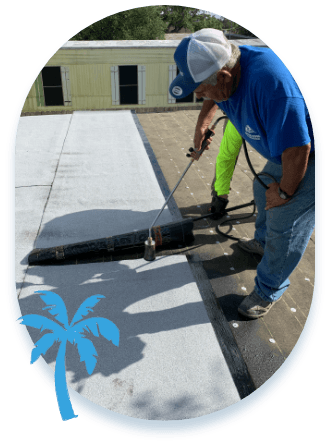Torch down is the most commonly used method for flat or slightly pitched roofs, but its official name is “modified bitumen.”
 It consists of a tough membrane that’s rolled out onto the roof deck and is treated with a thick layer of asphalt. The additives and resins in this material allow the roof to expand and contract, while other roofing systems will crack. Torch down roofing can bond with metal flashings, and it will even move with them — all while keeping a tight seal around the area. This kind of flexibility is why torch-down roofs are so widely used, and it has become a major factor in its overall success.
It consists of a tough membrane that’s rolled out onto the roof deck and is treated with a thick layer of asphalt. The additives and resins in this material allow the roof to expand and contract, while other roofing systems will crack. Torch down roofing can bond with metal flashings, and it will even move with them — all while keeping a tight seal around the area. This kind of flexibility is why torch-down roofs are so widely used, and it has become a major factor in its overall success.
The Advantages of Torch Down Roofing
Torch down roofing has several advantages. Not only is it resistant to rainwater, but it also offers protection from ultraviolet radiation. A torch-down roof will never melt or collect puddles of rainwater, so it’s weatherproof to a large extent. The mixture of asphalt and resin makes it extremely durable, and it’s resistant to punctures and other types of damage. Not only can a torch down roof last up to 20 years, but it also never needs to be repaired (except in the most extreme cases).
Torch down roofing can be installed in two or three layers. Both systems have a base and cap sheet, but a three-layer system will be finished with a granule cap sheet at the top. The extra layer will not only make it last longer but will also improve both its fire resistance and energy efficiency. Insulation may need to be applied (especially in colder climates) so the building can retain more heat. It will be attached to the roof deck with screws and plates, or it can adhere to the surface with glue or a hot-mop (depending on the type of deck or the performance requirements of the designer).
A special underlayment will also be applied to the deck, which can prevent the buildup of condensation or any other type of moisture. An overlay board will be attached to the roof deck, which will support the torch down roofing materials. This will include the base and cap sheets, which will go on top of everything else. A bitumen membrane will be applied around any fixtures that penetrate the roof (such as vents and HVAC units), which acts as an underlayment for metal flashing that will be installed on top of it.
Building owners may struggle with the decision of using a torch-down or hot mop roofing solution, which are both called Built-Up Roofing (BUR). But while both types of roofs have similar lifespans, a torch down system will have more resistance to punctures and ultraviolet radiation. While it is more expensive than a hot mop roof, torch down will give you more protection and will need fewer repairs. Be sure to speak to a roofing professional for more information.
Your Choice for Commercial Roofing in the Coastal Bend!
If you’re looking for one of the best commercial roofers in Corpus Christi, Bayfront Roofing and Construction has a team of experts that can handle any type of torch down installation or repair. We have years of combined experience in all areas of roofing, so we can handle any type of project. That’s why we’re your choice for commercial roofing in the Coastal Bend. If you want to know more about we can help you, feel free to reach out to us. We would be happy to speak with you!